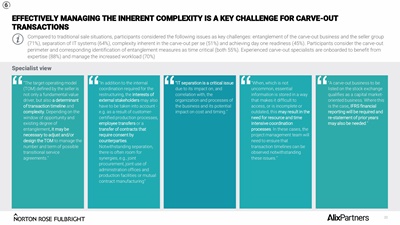
20
Specialist view
EFFECTIVELY MANAGING THE INHERENT COMPLEXITY IS A KEY CHALLENGE FOR CARVE-OUT
TRANSACTIONS
Compared to traditional sale situations, participants considered the following issues as key challenges: entanglement of the carve-out business and the seller group
(71%), separation of IT systems (64%), complexity inherent in the carve-out per se (51%) and achieving day one readiness (45%). Participants consider the carve-out
perimeter and corresponding identification of entanglement measures as time critical (both 55%). Experienced carve-out specialists are onboarded to benefit from
expertise (88%) and manage the increased workload (70%)
"The target operating model
(TOM) defined by the seller is
not only a fundamental value
driver, but also a determinant
of transaction timeline and
complexity. Depending on the
window of opportunity and
existing degree of
entanglement, it may be
necessary to adjust and/or
design the TOM to manage the
number and term of possible
transitional service
agreements."
"IT separation is a critical issue
due to its impact on, and
correlation with, the
organization and processes of
the business and its potential
impact on cost and timing."
"A carve-out business to be
listed on the stock exchange
qualifies as a capital marketoriented
business. Where this
is the case, IFRS financial
reporting will be required and
re-statement of prior years
may also be needed."
"When, which is not
uncommon, essential
information is stored in a way
that makes it difficult to
access, or is incomplete or
outdated, this may result in the
need for resource and time
intensive coordination
processes. In these cases, the
project management team will
need to ensure that
transaction timelines can be
observed notwithstanding
these issues."
"In addition to the internal
coordination required for the
restructuring, the interests of
external stakeholders may also
have to be taken into account e.g.
as a result of customercertified
production processes,
employee transfers or a
transfer of contracts that
require consent by
counterparties.
Notwithstanding separation,
there is often room for
synergies, e.g., joint
procurement, joint use of
administration offices and
production facilities or mutual
contract manufacturing"
6